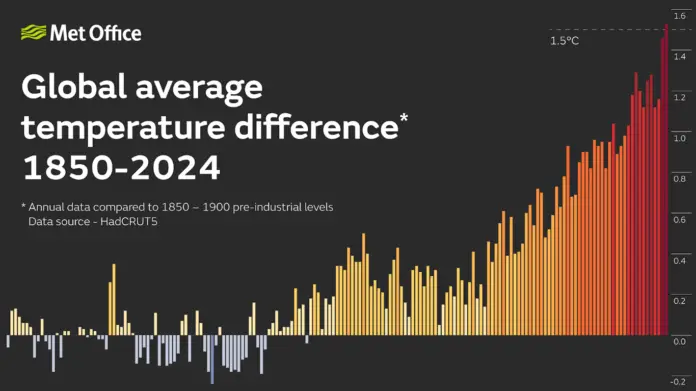2024 was the warmest year on record globally and the first year that was likely more than 1.5°C above pre-industrial levels: a stark reminder global temperatures are continuing to rise.
This is the 11th year in succession that has equalled or exceeded 1.0°C above the pre-industrial average period
number of global climate centres will be releasing their 2024 average temperature figures today.
The latest figures highlight how the world is getting closer to breaching the Paris Agreement target of 1.5°C, which considers the longer-term average temperature.
Commenting on the 2024 global temperature announcement, Minister for Climate Kerry McCarthy said: “There is much more work to be done to keep 1.5°C within reach and prevent climate catastrophe. The scale of the challenge is huge, but through collective action we can deliver change at the scale and pace required.”
Colin Morice of the Met Office said: “A single year exceeding 1.5°C above pre-industrial does not mean a breach of the Paris Agreement 1.5°C guard rail – that would require a temperature of at least 1.5°C on average over a longer period. However, it does show that the headroom to avoid an exceedance of 1.5°C, over a sustained period, is now wafer thin.”
Professor Rowan Sutton, Director of the Met Office Hadley Centre added: “By itself 1.5°C does not represent a cliff edge in terms of climate impacts, but every fraction of a degree rise in global temperature increases the frequency and severity of extreme weather events, commits the world to greater rises in sea level and increases the risk of crossing potential planet-altering tipping points such as breakdown of the Amazon rainforest biome or ice sheet collapse in Greenland or the Antarctic.”
“This notable landmark further highlights the urgency of efforts to minimise future warming.”
Professor Tim Osborn, Director of UEA’s Climatic Research Unit, said: “The world as a whole has not yet begun to reduce its use of fossil gas, oil and coal, so emissions of CO2 have not yet peaked and as a result the global temperature continues to rise as predicted by climate scientists.”
“Superimposed on the long-term trend are small ups and downs that typically last a year or two and arise mostly from natural variability. These small variations of 0.1 to 0.2°C can temporarily push the global temperature above or below its underlying warming trend and make an individual year such as 2024 exceed 1.5°C even though the underlying warming has not quite reached that level yet.”







